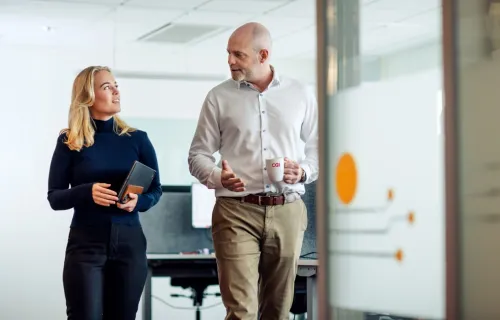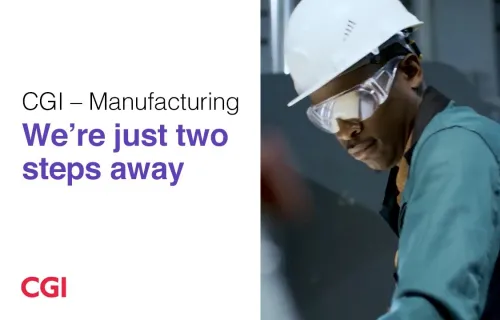A digital factory also called the “factory of the future,” is central to manufacturers’ digital transformation journey. It offers numerous benefits; however, transforming the factory floor and operating holistically is not without its challenges. In a keynote at the Power of Unified Manufacturing event, CGI’s Coen Huesmann explored the concept of the “Factory of the Future” along with guest speaker Ion Russu, COO of Butachimie and CGI’s Nathalie Guerrin and Jean-Louis Reynaud.
This article provides highlights from the discussion.
A transversal and agile approach to address new challenges
“If you were to build a factory today, you would build a connected factory. A factory where data is gathered continuously from all the devices in the factory. This factory would be driven by data and operated by AI and algorithms that are continuously learning to improve,” says Coen. In the factory of the future, many things need to be considered—from IT and OT integration and how deep it should go to shifting production to the cloud and ensuring security. What is multinational chemical manufacturer Butachimie’s experience in operating and realizing the benefits of a digital factory?
Butachimie began its journey three years ago with a focus on achieving the “classic goals” of becoming more efficient, sharing data with suppliers, reducing execution time and improving operations. “We have restructured our approach to one that is transversal and agile for IT, OT, security and mobility on the field,” says Ion. He adds that when the pandemic hit, the company’s solid digital foundations enabled them to transition all their employees to remote work within three weeks. He says that a transversal and agile approach helped navigate new challenges, particularly protecting against increasing cyber threats during the last three years.
Staying ahead of cybersecurity threats
Security is an ever-increasing challenge for manufacturers. In the 2022 CGI Voice of Our Clients, manufacturing CXOs cite cybersecurity as the most impactful industry trend. Digital factories, digitally connected value chains and more open and connected ecosystems have widened the specter of threats, requiring manufacturers to be highly vigilant and prepared.
Operating securely with multiple plants, processes and personnel is a complex exercise. Ion outlined Butchimie’s approach to running secure operations, which focuses on four key areas:
- Physical security of employees;
- Process security;
- Protection of intellectual property (IP); and
- IT/ OT security
He states that digitalization and automation are vital to ensure physical and process security. Butachimie’s advanced process control (APC) and high-performance computing (HPC) initiatives are showing positive results, with both the automation programs helping to improve efficiency, productivity and safety control.
To protect their intellectual property, he says, the company has developed different levels of security. He cites the example of sharing technical designs—parts of which may include company IP—with various suppliers. Butachimie has developed software with their partners that allows access on a “need to know” basis. “You can only access the parts you are working on and not the whole document,” Ion explains. Choosing a digital rather than a paper-based approach allows manufacturers to be more discerning about what is shared.
Coen notes a similar situation arising when manufacturers install new equipment. “Most equipment suppliers have access to part of the equipment because they want to help with continuous and preventive or predictive maintenance. This includes access to data and certain files that you may want to keep safe,” he says. As manufacturing moves toward operating in complex ecosystems, finding a balance between ensuring security and being “open enough” to support improvements will be essential.
The business value of sustainability
It is unquestionable. Embedding sustainability is critical for manufacturers to activate their climate pledges and achieve long-term business value. Ion says Butachimie has demonstrated clear successes in realizing sustainability objectives by optimizing operations digitally. “We changed our technology in 2019. Moving to new technology for operating our plant, we have been able to reduce our carbon footprint by 15% with the same production level,” he says. By continuing this transformation, they are excited about what can be achieved in the next five years.
Speaking about the challenge of attracting talent, Ion states, “We have a real approach with concrete measures and actions for moving forward and significantly reducing our carbon footprint and other emissions or pollution.” He says the ability to demonstrate sustainability appeals to many job seekers today who are looking to derive a sense of purpose from their work.
Given the industry’s impact on climate change and the growing number of technologies to help mitigate the crisis, Coen advises: “If you want to make a real difference in environmental impact, then manufacturing is the place to be.” Jean-Louis agrees on the vast opportunities to use technology to drive sustainability, from optimizing production cycles and energy usage to reducing greenhouse gas emissions and prolonging asset life with predictive maintenance. “These are concrete actions and not greenwashing,” he says, adding that this can motivate younger generations to join the industry and make a difference while supporting manufacturers in securing future talent.
Using an agile approach to scale innovation
Butachimie is exploring new ways of advancing innovation through an agile approach. “While developing the different software for protecting IP, we discovered that we can also use it for safe and protected mobility,” says Ion. The company has installed a private 4G network to support secure mobility for field operations. With connected tablets, their workforce now carries out maintenance, installation and inspection tasks much quicker. It also means engineers don’t need to carry paper-based technical designs to the field but can access them digitally and securely via tablets. While the initiative is still in its early days, Ion says they’ve already seen a 20% decrease in execution time.
Sharing his recommendations for starting a transformation journey, Ion says it is critical to get consensus on the strategy, priorities and goals. He adds that preparation is key. “Prepare, prepare and prepare. The last point is, even if you have this preparation, you prepare so you are enabled not to stick to it. So, keep that agility.”






